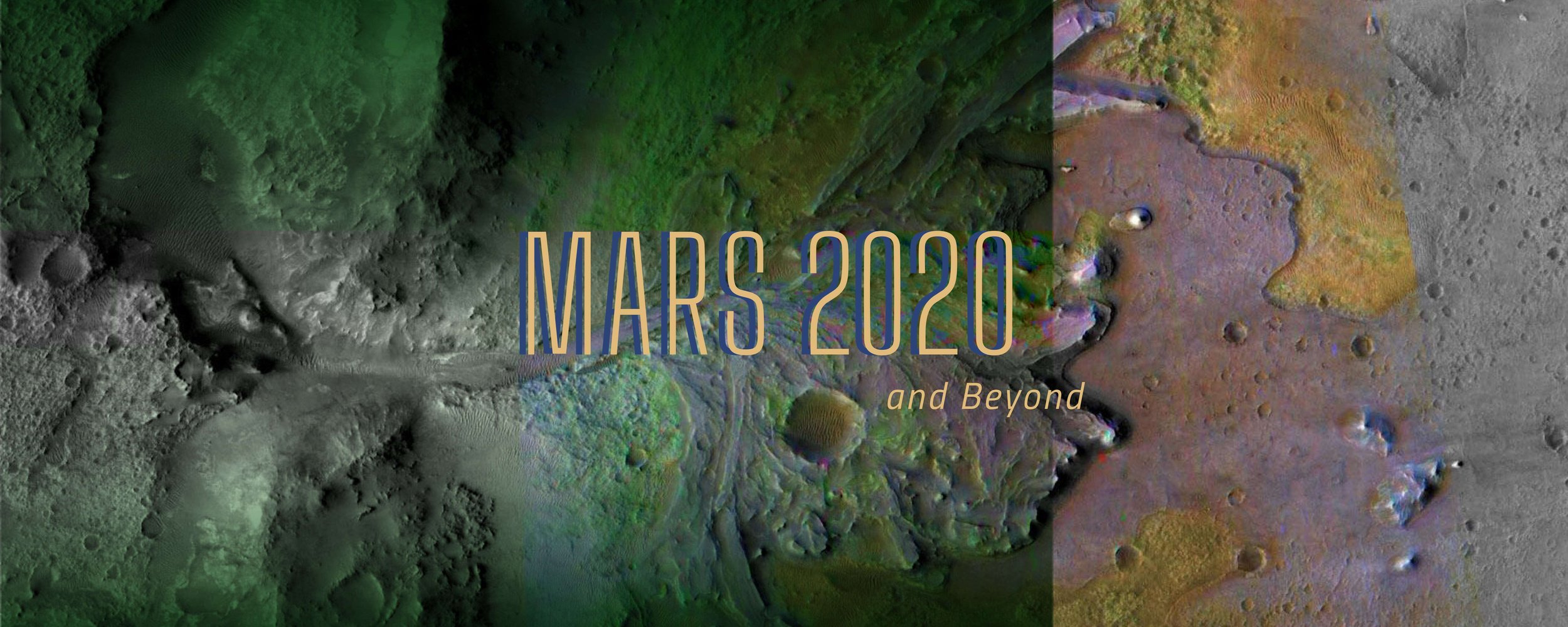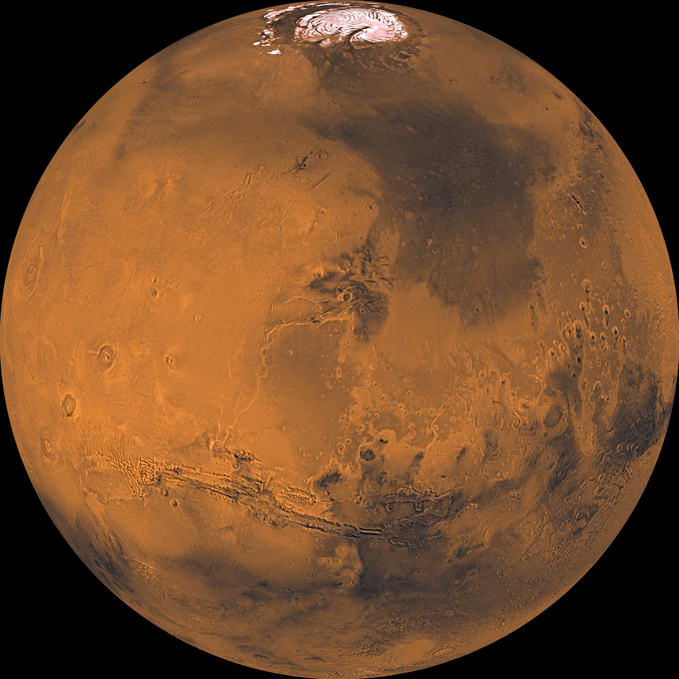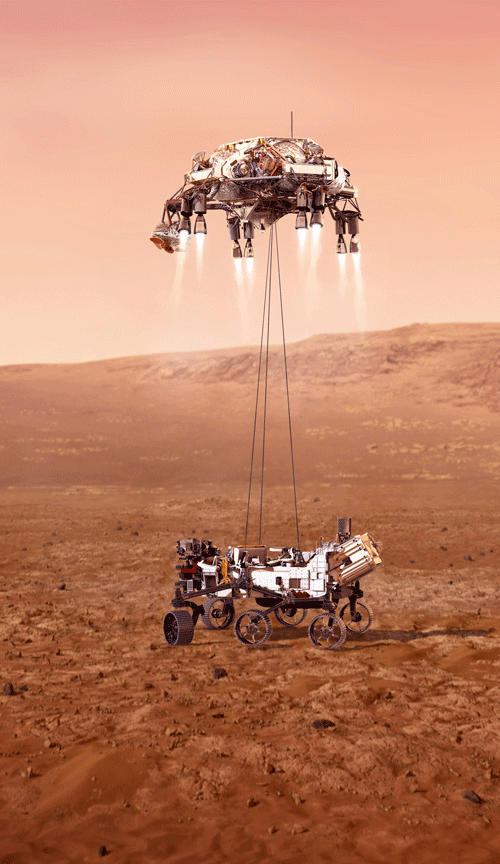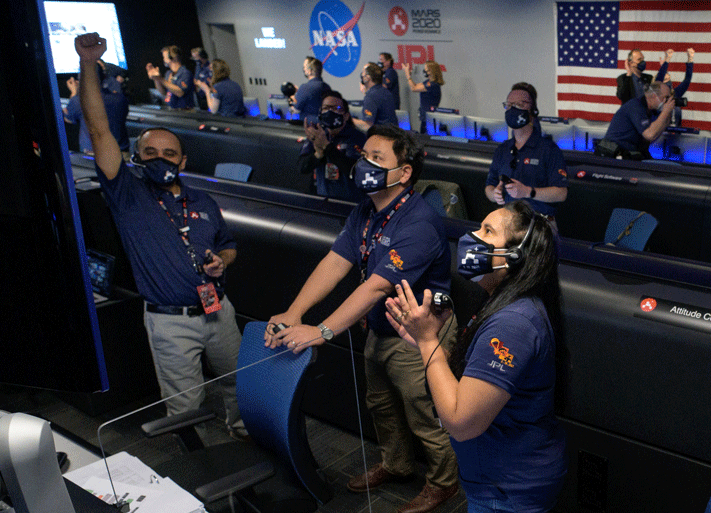
Mars 2020 and Beyond
SCS Alumni Discuss Current and Future Space Exploration
Kevin O’Connell
Perseverance touched down on the floor of Jezero Crater on Feb. 18, 2021. Image courtesy of NASA.
With so much emphasis on SCS’ Moon Missions, it’s sometimes easy to forget that SCS alumni remain fast at work on the mission to Mars and are involved with plans for missions beyond.
A virtual panel discussion held in May 2022 and hosted by Martial Hebert, dean of SCS, revealed some key insights into the future direction of the space programs in the U.S., and some thoughts on potential destinations space program scientists might set their sights on next.
As this panel discussion indicates, SCS alumni remain highly influential and sought after for all aspects of space exploration. What you will read is a summation and excerption. The full webinar, which can be viewed in its entirety online at: https://www.youtube.com/watch?v=EH6mwGfhvRE

The Mars 2020 Panelists
Andrew Johnson (SCS 1997)
Principal Robotics System Engineer, NASA Jet Propulsion Laboratory
Since joining JPL in 1997, Andrew E. Johnson has been developing technologies and flight systems for autonomous navigation and mapping during descent to planets, moons, comets and asteroids. For the Mars Exploration Rovers, he was lead developer for the Descent Image Motion Estimation System, and on Mars 2020 he led the development of the Lander Vision System that provided surface relative position estimates for Terrain Relative Navigation. He was also the manager of the Mars 2020 Guidance Navigation and Control subsystem which included cruise, EDL and surface mission functions.
Emily Newman (SCS 2019)
Software Systems Engineer, NASA Jet Propulsion Laboratory
Emily Newman joined JPL in 2019 shortly after graduating from Carnegie Mellon University with an undergraduate degree in computer science and robotics. She was the lead developer for the telemetry processing backend of the Mars 2020 Entry Descent Landing visualization, which was used to display Perseverance’s landing live to millions of viewers. She has also worked on other projects within the Mission Control Systems section, including a cybersecurity network visualization and a system for storing mission data. She currently works on robotic operations for the Curiosity rover.
Vandi Verma (SCS 2002, 2005)
Deputy Manager for Mobility and Robotics Systems, NASA Jet Propulsion Laboratory
Chief Engineer of Robotic Operations for Mars 2020 Perseverance & Ingenuity
Vandi Verma has worked on space robotics, AI research and technology development and has designed, developed and operated rovers on Mars. She leads about 170 JPL roboticists developing new technology for future missions and working on a variety of JPL robotic missions. She has been engaged in robotic operations on Mars since 2008 with the Mars Exploration Rovers Spirit and Opportunity, Curiosity rover, Perseverance rover and Ingenuity helicopter.
The Landing
When Andrew Johnson (SCS 1997), principal robotics system engineer for NASA’s Jet Propulsion Laboratory, first started at JPL, the Pathfinder rover had recently landed on Mars. It did so without much use of computer vision. Since this field of study had always been his focus, Johnson strived to apply computer vision to the landing apparatuses for future planetary exploration missions.
“That's been my objective my entire career — to increase the vision and the autonomy of the spacecraft when they're landing,” said Johnson.
It was a perfect match of Johnson’s passions and JPL being the precise place for them. Johnson helped design the Lander Visual System (LVS) for the Mars Perseverance rover. The LVS is a terrain-relative navigation system which operates during the parachute phase of the landing. The LVS takes a sequence of images and matches landmarks in them to a map built from satellite imagery. This helps the lander to see where it is, relative to the surface, and allows the onboard system to target the optimal landing spot within the eight-kilometer landing ellipse located at the Jezero Crater.
NASA artist’s depiction of the “7 minutes of hell” as the Mars lander utilizes the Lander Visual System to bring the Perseverance Rover and Ingenuity Copter to the surface of Mars.
The first high-resolution, color image to be sent back by the Hazard Cameras (Hazcams) on the underside of NASA’s Perseverance Mars rover after its landing on Feb. 18, 2021. Image courtesy of NASA.
The Mars 2020 mission was the first to ever use this type of landing system and it succeeded despite hazardous conditions. Jezero Crater, comprised of steep cliffs from an ancient river delta, large craters, inescapable dune fields and boulder fields, presented many challenges to finding a safe landing spot.
“The system had enough fuel on board to divert to a safe location,” said Johnson. “It did not have enough fuel, however, to go to a very specific point. So, the system targeted one of the safest locations that was nearby.”
Along with saving the mission — and millions of dollars in equipment — getting Perseverance safely to the ground represented a major milestone accomplishment. The first of its kind, it has set the standard for future landings. Johnson and his team have moved on to the next mission, the Mars Sample Retrieval Lander.
“It's going to also need this terrain relative navigation capability,” said Johnson, “and we'll in fact do pinpoint landing — meaning landing in a very specific spot where the samples that Mars Perseverance has collected will be put down onto the surface. And it also could apply to other science missions.”
“That’s been my objective my entire career – to increase the vision and the autonomy of the spacecraft when they’re landing.”

The Roving
Before the Sample Retrieval Lander travels to Mars, Vandi Verma (SCS 2005), chief engineer of robotic operations for Mars 2020, has work to do on the surface operations side of the mission, driving the Perseverance rover — her fourth Mars rover — and the Ingenuity helicopter around the planet’s surface collecting samples with the goal of studying the geology and astrobiology of Mars, and preparing for the arrival of astronauts. The Jezero Crater River Delta was chosen because it has the highest likelihood of finding signs of life on the red planet.
NASA artist's rendering of the Perseverance Rover and the Ingenuity Helicopter on the surface of Mars, as part of the ongoing Mars 2020 Mission.
“We've got an instrument that can synthesize oxygen from the atmosphere,” said Verma.
Access to plenty of oxygen is critical to the success of any mission to Mars with humans. “The main part of this mission is to core,” said Verma, which means to “have a robotic drill that cores under the surface, collect sample cores, intact and caches them for subsequent return to Earth.” Verma points out that it will be the first time samples from Mars will be brought back to Earth.
Communicating with a planet as far away as Mars remains a slow business. It takes 24 minutes for the team to send a message to the rover telling it where to go next. Three towers located around the globe make up the antenna that keeps the team in contact with Perseverance, but it takes time to analyze what the rover is seeing and communicate its next move.
As a result, some level of autonomy assisted Perseverance’s forward progress. Because the LVS lander chose a slightly different location for the safety of the landing, Perseverance had to cover extra ground to make its way back to the river delta region of the Jezero Crater. To accomplish this, the team utilized information gathered from the Ingenuity copter as well as Perseverance’s own autonomous navigation to arrive as quickly as possible. The team tells Perseverance the targeted locations goal and it uses autonomy to avoid hazards. Using computer vision, stereo processing with cameras and a lot of algorithms for how it models uncertainty onboard, the rover then combines this information with its autonomous algorithm to decide the best path.
Another navigation tool at the team's disposal were the images gathered by the Ingenuity helicopter. “We'd send it ahead to scout out areas and see if we really wanted to send the rover there, and that was very valuable,” said Verma.
The autonomous navigation resulted in Perseverance covering five kilometers in just three weeks, which is “kind of unheard of in planetary robotics terms,” said Verma. And Ingenuity has proven more durable than originally thought. “Ingenuity was supposed to last for three flights,” said Verma. At the time of this publication, that number was 33 flights.
The Visualization
NASA artist's depiction of the Perseverance touch down on Mars.
While the lander was in its descent — a time known as the seven minutes of terror — the world watched live. And they were able to do so, in part, because of the expertise of Emily Newman (SCS 2019), software systems engineer at JPL. Newman and her team built a web-based, real-time visualization for use by the Mars 2020 engineers during the Entry, Descent and Landing (EDL) trajectory design, testing and observation phases of the mission.
“Essentially this started as an engineering tool for EDL engineers,” said Newman. “We wrote it for them to use to test their simulations.” But the visualization test system became the one used on landing day to show the current status of the spacecraft.
“We were able to process many different sources of data and then stream it in real time,” said Newman. “This included simulation data from MATLAB files, as well as mission support testbed data, which we basically ran in tandem with the testbed for many different sessions and made the webpage available to engineers who were able to watch it while the testbed sessions were running.” And, of course, the team also used it during more tests that were specific to the EDL landing scenario.
The stream of the Perseverance landing utilized by the operations teams was also intended to run over NASA TV, which it did. CNN also picked it up and ran it live in Times Square. The stream was viewed by President Biden and essentially anyone in the world who wanted to watch.
“I think it was really cool as a public outreach effort for JPL,” said Newman. “An operational system on landing day was just a MacBook Pro laptop, so my manager's laptop was just looking at this web client and streaming it to everybody.” ■
The Mars 2020 team at NASA celebrates the successful landing of the Mars Perseverance rover. Image courtesy of NASA.

Where Might SCS Go Next?
When asked about finding evidence of past life on Mars, Verma spoke optimistically. “We do think we’re going to find signs of potential past life, that’s kind of why we're there,” she said. “And the probability [that life exists] somewhere in the universe, in the solar system, per se. So, we’re sending increasingly complex instruments that are able to collect information to piece together the puzzle.”
An artist’s “selfie” of the Perseverance rover and Ingenuity copter on the surface of Mars. Image courtesy of NASA.
Enceladus, a moon of Saturn and the brightest object in the solar system, has been listed by the space science community as a potential location for future missions. Image Credit: NASA/JPL/Space Science Institute
Where to look for that life and where to go next to conduct experiments changes with each scientific discovery. The community of space scientists recently released its Planetary Science Decadal Survey, in which they set the scientific goals of future missions, guiding, in part, what those missions might be. The report identified potential in Enceladus, a moon of Saturn, and the brightest object in the solar system. Covered in ice and with an ocean beneath the ice, Enceladus has plumes coming out of its south pole that could contain material from that ocean.
“That’s a very exciting robotic and autonomous mission, to go there and get something from those plumes,” said Johnson, “because if there’s an ocean, there could potentially be life in the ocean, and if you're sending particles out, you possibly could capture some of that life in those particles. So that's really compelling. That would require new architectures.”
The report also lists Europa, a moon of Jupiter that is also icy and contains a global ocean.
“We have Clipper coming up, which will do a flyby of Europa – that’s a big mission that JPL is working on with other organizations,” said Johnson. “And then there's NASA's push to go back to the Moon.”
In order for humans to land on the Moon and for future robotic landings, ongoing development of terrain relative navigation will be coupled with a technology called hazard detection and avoidance, where you build a map of the ground to identify hazards you can't see from orbit.
Newman, Johnson and Verma all pointed to their time at SCS as being highly influential on their careers, and for enhancing their concept of working on teams — especially complex and diverse teams like they encounter at JPL.
“You get to work with experts in a variety of fields who all work together,” said Verma. “On that landing day, you feel the sense of teamwork. So, if you like working with a set of people toward a common purpose, the purpose is important … but it’s also a lot of fun to work with people who are all very good at what they do.”












